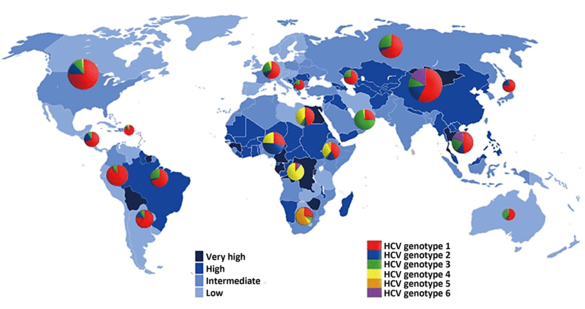Hepatitis C Virus
OVERVIEW
HCV is the major etiologic agent of sporadic and transfusion-associated non-A, non-B hepatitis worldwide. Ca. 50% of all infections lead to chronic liver disease with varied clinical manifestations ranging from a largely asymptomatic carrier state to chronic active hepatitis, liver cirrhosis and hepatocellular carcinoma.
Geographic Pattern of HCV Prevalence
HCV is transmitted primarily via the parenteral route, but with the implementation of diagnostic tests to exclude HCV-contaminated blood products, the incidence of new HCV infections declined drastically.
Nevertheless, HCV is still an important medical problem, because about 58 million people are persistently infected with this virus and have a high risk to develop severe chronic liver disease such as liver cirrhosis and hepatocellular carcinoma.
CCurrent antiviral therapy allows virus elimination and almost all chronic HCV carriers. Although, inspired by this fact, the World Health Organization (WHO) has declared to reduce the incidence of HCV infections by 90% and mortality by 65% until 2030, still around 1.5 million new infections occur every year. In addition, access to treatment and diagnosis is limited. Therefore, there is a need for a prophylactic vaccine, but its development is challenging in many respects such as the extremely high variability of HCV.
Based on sequence analyses, HCV genomes can be grouped into at least 6 genotypes or 'clades' and multiple subtypes. In Western Europe and the United States, infections caused by genotypes 1a [the American prototype] and 1b [the Japanese prototype] are the most frequent ones, followed by infections with the genotypes 2 and 3. The other genotypes are very rare in these countries and can only be found in distinct geographical regions like Egypt (genotype 4), South Africa (genotype 5), and Southeast Asia (genotype 6).
